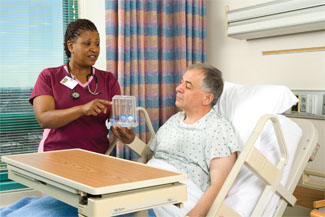Purpose
- Provides incentives via visual clues to the client regarding effective deep breathing.
- Improves pulmonary ventilation and oxygenation, loosens respiratory secretions, and prevents or treats atelectasis by expanding collapsed alveoli.
Assessment
- Identify clients at risk for atelectasis.
- Complete respiratory assessment (i.e., history of smoking, breath sounds, respiratory rate and rhythm, sputum production) (Fig. 1).

Fig. 1: Assess breath sounds.
Equipment
- Incentive spirometer (flow-oriented or volume-oriented; type of incentive spirometer is usually determined by equipment available through respiratory therapy)
Procedure
-
Verify the physician order and identify the client.
Rationale: Prevents potential errors and order is required for reimbursement.
-
Wash your hands.
Rationale: Handwashing reduces transfer of microorganisms.
-
Assist client to high Fowler's or sitting position.
Rationale: These positions facilitate optimal lung expansion.
-
Determine the volume to set incentive spirometry goal based on calculated lung volumes. You may use chart or have respiratory therapy calculated. Set volume indicator. Explain goal to client (Fig. 2).
Rationale: People of different sizes have different lung capacities. Individualize preset goal to promote optimal lung inflation and provide realistic motivation.
-
Instruct client in procedure:
-
Seal lips tightly around mouthpiece.
Rationale: A sealed mouthpiece prevents leakage of air around mouthpiece.
-
Inhale slowly and deeply through mouth. Hold breath for 2 or 3 seconds (Fig. 3).
Rationale: Holding the breath maintains maximal inflation of alveoli.
-
Have client observe his or her progress by watching the balls elevate or lights go on, depending on type of equipment used (Fig. 4).
Rationale: Observing progress provides visual feedback to the client regarding depth of inspiration, which motivates client to breathe deeply.
-
Exhale slowly around mouthpiece and breathe normally for several breaths.
Rationale: Prevents hyperventilation.
-
Seal lips tightly around mouthpiece.
-
Repeat procedure 5 to 10 times every 1 to 2 hours, per physician's orders.
Rationale: Frequent use will prevent alveoli collapse.

Fig. 2: Encourage client to reach goal.

Fig. 3: Instruct client to inhale slowly and deeply.

Fig. 4: Observe progress of elevating balls.
| Sample Documentation | |||
| 12/12/10 | 1500 | Using IS every hour while awake obtaining goal of 500 mL, lung sounds clear to auscultation. S. Roberts, RN | |
Lifespan Considerations
- Clients who are too young to follow directions, are cognitively impaired or malnourished, or lack necessary motor skills are likely to be unsuccessful at using incentive spirometry.
Collaboration and Delegation
- Respiratory therapy often provides the initial instruction on how to use the incentive spirometer, calculating a realistic lung volume. For preoperative clients, try to coordinate teaching before surgery.